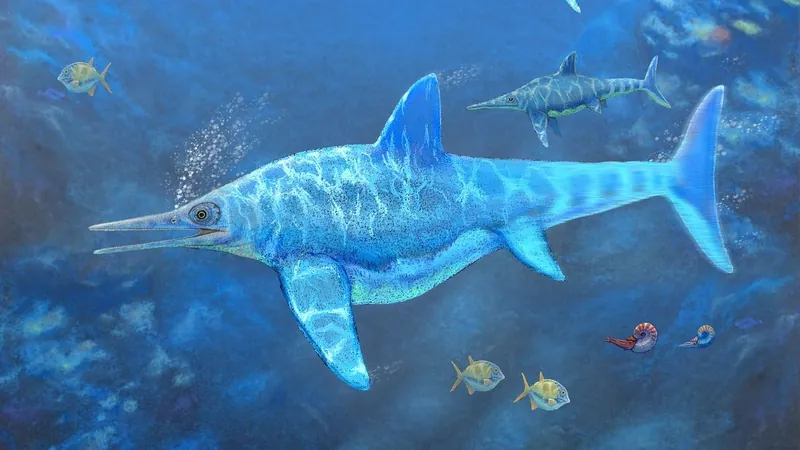
Ancient Sea Monster Shockingly Found Pregnant with Twins! 131-Million-Year-Old Fossil Unveils Stunning Secrets
2025-04-03
Author: Siti
Ancient Sea Monster Shockingly Found Pregnant with Twins!
In an astonishing discovery that has sent waves through the paleontological community, researchers have revealed that an ancient marine reptile fossil, dating back 131 million years, was pregnant with twins at the time of its death. This incredible revelation comes from a comprehensive analysis, including a CT scan, of the fossilized remains of an ichthyosaur, a dolphin-like predator that dominated the seas during the Mesozoic era.
Judith Pardo-Pérez, a paleontologist from the University of Magallanes in Chile, discovered the fossil back in 2009, but only recently confirmed the presence of two infants within the skeletal remains. "Twins! She has another baby," she exclaimed, promising to share more insights in an upcoming research publication.
The Discovery
The fossil was unearthed in the picturesque surroundings of Torres del Paine National Park in southern Chile, where researchers struck paleontological gold almost sixteen years ago. Initially, the preserved remains showcased a single fetus measuring about 6 inches long. However, after further examination, Pardo-Pérez and her colleagues unveiled the unexpected presence of a second fetus, both in remarkably preserved condition.
Details of the Ichthyosaur
This particular ichthyosaur, scientifically named Myobradypterygius hauthali, measured approximately 11.5 feet (3.5 meters) long—an impressive size for its time. Unique circumstances surrounding its preservation, including rapid burial in sediment and minimal scavenger activity due to low oxygen levels at the seafloor, contributed to the remarkable fidelity of the fossil.
Significance of the Find
What’s more, this find stands out as the third instance of a pregnant ichthyosaur from the Cretaceous period, with other pregnant specimens found in earlier Jurassic and Triassic layers. Notably, the vertebrae of the fetuses are relatively large compared to the mother's body length, hinting that M. hauthali may have birthed relatively sizable young—a fascinating consideration for evolutionary studies.
Birthing Methods
Interestingly, the position of the fetus inside the fossil provides clues into the birthing methods of ancient ichthyosaurs. Unlike some predecessors that might have given birth head first, this evidence suggests a tail-first delivery, much like the birthing process observed in modern dolphins and whales.
Dietary Insights
Additionally, the discovery has offered a rare glimpse into the diet of this ancient predator; Fiona’s last meal consisted of small fish remains, a valuable insight into the dietary practices of Cretaceous marine reptiles.
Future Research
As Pardo-Pérez continues her studies, including advanced imaging techniques, she plans to unveil further details about the implications of this find on our understanding of ichthyosaur reproduction and biology. With each new revelation, the depths of our knowledge about these ancient sea giants grow deeper, promising more exciting discoveries in the future! Keep your eyes peeled for the upcoming research that could change everything we know about prehistoric marine life!


 Brasil (PT)
Brasil (PT)
 Canada (EN)
Canada (EN)
 Chile (ES)
Chile (ES)
 Česko (CS)
Česko (CS)
 대한민국 (KO)
대한민국 (KO)
 España (ES)
España (ES)
 France (FR)
France (FR)
 Hong Kong (EN)
Hong Kong (EN)
 Italia (IT)
Italia (IT)
 日本 (JA)
日本 (JA)
 Magyarország (HU)
Magyarország (HU)
 Norge (NO)
Norge (NO)
 Polska (PL)
Polska (PL)
 Schweiz (DE)
Schweiz (DE)
 Singapore (EN)
Singapore (EN)
 Sverige (SV)
Sverige (SV)
 Suomi (FI)
Suomi (FI)
 Türkiye (TR)
Türkiye (TR)
 الإمارات العربية المتحدة (AR)
الإمارات العربية المتحدة (AR)